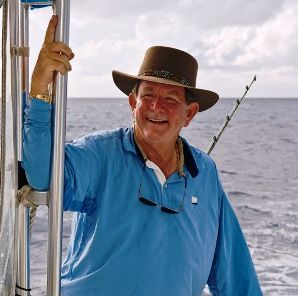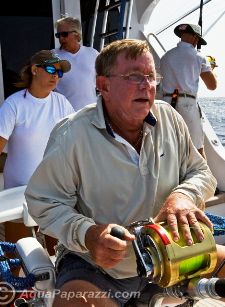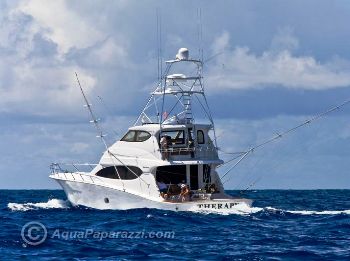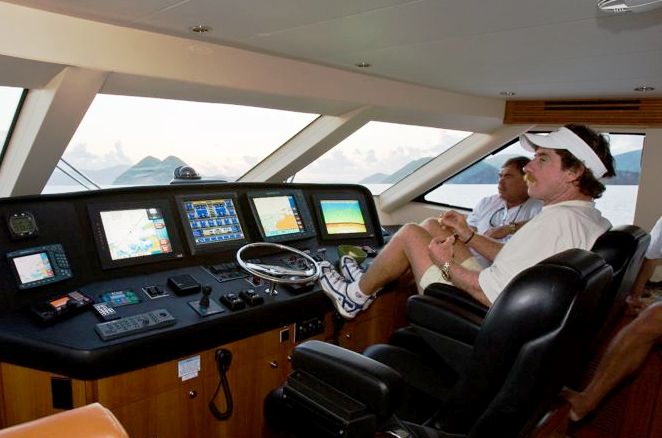 George Lorton came late to the bill fishing life. But, he's made up time in the last several years by racking up some impressive tournament wins - and fish stories.
George Lorton came late to the bill fishing life. But, he's made up time in the last several years by racking up some impressive tournament wins - and fish stories.
A native of Tampa, Florida, Lorton says, "I've always had an interest in fishing. Early on, I fished on the lakes and streams throughout Florida or went grouper digging in the Gulf."
In 1995, Lorton's brother had a heart attack. "When he recovered, I told him to take some of our money and go buy us a boat. We got a 53-foot Hatteras and named her 'Therapy' because that's just what my brother needed."
A friend told Lorton that with a boat that size he should get into billfishing. The problem was that Lorton didn't know how. He needed the right rigging and instruction.
"My friend told me to give him $15,000 and he'd set us up with outriggers, rods, reels, just what we needed. I gave him the money and afterwards thought I should have asked him what's the biggest marlin he had ever caught. But, I didn't."
After getting the boat outfitted, Lorton installed $10,000 worth of fish-finding electronics. At that point, his friend told him he was ready for a tournament.
 "We were slow bellying out on the Gulf and that's when I remembered. So, I asked my friend, 'what's was the biggest marlin you've ever caught'," Lorton recalls. "He told me he had never caught one. Ever. Well, there I am thinking that I gave this guy all this money to ready my boat and he had never caught a marlin before. As it turns out, he'd readied boats for three other owners and every time he drew the short end of the stick and didn't get any chair time."
"We were slow bellying out on the Gulf and that's when I remembered. So, I asked my friend, 'what's was the biggest marlin you've ever caught'," Lorton recalls. "He told me he had never caught one. Ever. Well, there I am thinking that I gave this guy all this money to ready my boat and he had never caught a marlin before. As it turns out, he'd readied boats for three other owners and every time he drew the short end of the stick and didn't get any chair time."
Lorton remedied this situation fast. "Our first day out fishing, I put him in the chair. He ended up catching a marlin about 2-inches short of legal size. I caught a 342-pounder, and my electronics man, who I had on board to make sure everything was working well, caught a 500-plus-pound marlin."
He continues, "You might say I caught my first marlin that day and also got hooked on the sport."
The same friend who got Lorton rigged, ready and reeled in, urged him to fish the Bahamas Billfish Championship (BBC) circuit.
"That was 1996 and 1997," he says. "We won the title both years back to back. The bottom line is that we caught a lot of fish and released a lot too, probably more fish in those two years than had been caught in the history of the tournament, although that record's since been broken. Two people have won the BBC twice and one of them was me. We were hot back then."
Lorton likes to fish with a variety of line test - 50-pound, 80-pound, 100-pound, whatever a tournament requires in its rules. "We don't use live baits. It's all lures. Teasers off the transom and pitch baiting are fun. It improves the odds of a hook-up from 50:50 to 80:20 or 70:30, depending on who you are talking to. Pitching right into a marlin's mouth is also pretty exciting - when it works."
One of Lorton's most memorable fishing days happened a few years ago while he angled off the bar north of Harbour Island in the Bahamas. He tells the tale this way: "I hooked up what we thought was an 800-plus-pounder. That fish hit the long rigger, leap-frogged and greyhounded across the water and went right for the transom.  We were black stacking the diesels to get away before the fish landed in the cockpit. He came short, then sounded. Then, all of a sudden, here he came again. This time, from 150 yards away, he went for the starboard side and started doing all this crazy behavior now twice in a row. I ended up fighting that fish for 2 1/2 hours. Finally, it came up alongside, rolled up on its side and looked me right in the eye. Then it rolled the lure around in its mouth and spit it into my lap. With that, it swam away. It was as if the fish said, 'I've had enough of this for one day, I'm done'. That was square with me. It was probably one of the most incredible experiences in my life."
We were black stacking the diesels to get away before the fish landed in the cockpit. He came short, then sounded. Then, all of a sudden, here he came again. This time, from 150 yards away, he went for the starboard side and started doing all this crazy behavior now twice in a row. I ended up fighting that fish for 2 1/2 hours. Finally, it came up alongside, rolled up on its side and looked me right in the eye. Then it rolled the lure around in its mouth and spit it into my lap. With that, it swam away. It was as if the fish said, 'I've had enough of this for one day, I'm done'. That was square with me. It was probably one of the most incredible experiences in my life."
Through his fishing career, Lorton says, "We've been out on days where there have been 15 to 20 foot seas. Days where you come on top of a wave, a black hole opens beneath you and you can see sea bottom. You wonder why you're headed out fishing, but you go anyway."
Lorton gives his Hatteras credit for taking such a beating. In fact, when he moved up to a 68-footer, he also chose the Hatteras brand. One of the unique features on the new 'Therapy' is a school of baitfish painted on the undersides.
What also adds to Therapy's mystique is the team's lures. Lorton explains, "My captain, Ray Walters, and I go pheasant hunting in South Dakota each year. We use the features to make our lures."
He adds, "Ray is a great all-around sports man. He can tell the size of a blue marlin in a split second, so we know if it's to be a release or a money fish if we're fishing a tournament."
 Lorton fishes 10 to 12 tournaments a year. "We start out in April and head over to the Bahamas for the BBC. Then, we're down in St. Thomas by the Fourth of July. We'll fish the Bitter End tournament in the BVI and the Boy Scouts out of St. Thomas. We'll usually stay in St. Thomas through the October moon."
Lorton fishes 10 to 12 tournaments a year. "We start out in April and head over to the Bahamas for the BBC. Then, we're down in St. Thomas by the Fourth of July. We'll fish the Bitter End tournament in the BVI and the Boy Scouts out of St. Thomas. We'll usually stay in St. Thomas through the October moon."
Getting a chance to fish is more competitive these days, Lorton jokes. "My step-daughter caught her first blue marlin at age 11. Then last year, my wife Denise caught her first marlin. Now, there's this friendly rivalry between my wife and daughter to see who's going to get to the rod first when there's a strike."
But, he adds, "I'm the kind of person who enjoys watching someone catch a marlin as much as I enjoy doing the catching myself."
When Lorton isn't out fishing, he says, "I dabble in real estate and ship yards. I just bought another shipyard last year. I actually own seven businesses, including a funeral home."
In the future, he predicts, "The sport has to be more conservation oriented. I'm afraid that, considering the cost of fuel and with other expenses rising, there will be fewer and fewer sports fishermen going after fewer and fewer fish. I'd like to see that different though. In fact, what I'd like to see is how it is in St. Thomas. You can go out and catch 5, 6 or 7 blue marlin a day, and go out the next day and be able to do the same thing."
Photos by Scott Kerrigan
